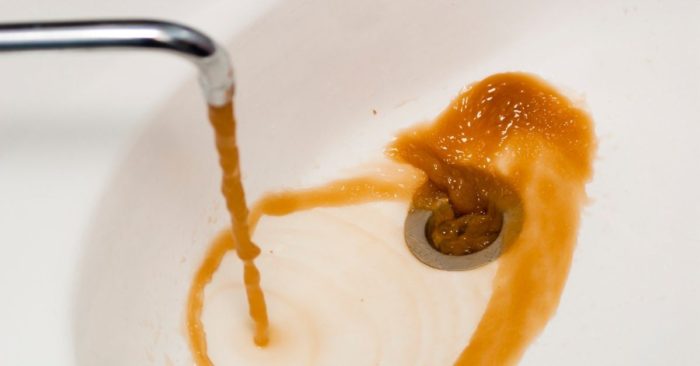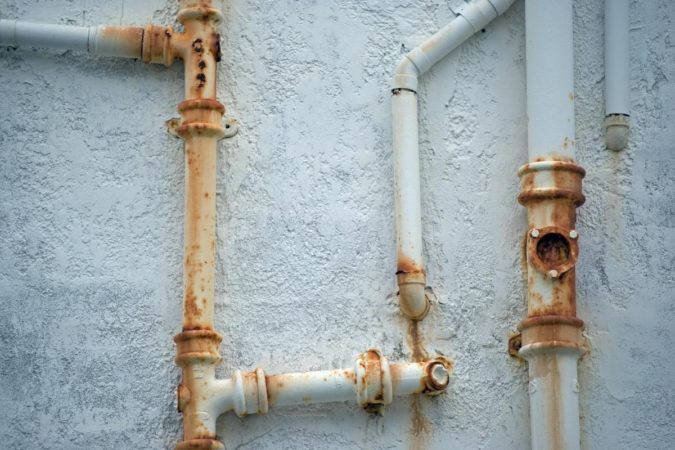Brown water supply running from faucets is the nightmare of every household. The most effective way to get rid of brown well water is by using water filters such as a salt-based water softener, reverse osmosis, and greensand filter.
Seeing brown water pouring into your glass or sink is never pretty. Brown well water is a contamination problem that’s more prevalent among private well owners.

Is brown water dangerous? Some cases of brown well water are more severe than others. However, the health risk brown water poses depends on the degree of water contamination.
Aside from the unpleasant appearance of dirty water, there are evident signs of brown well water in your home. When you see such signs on your bathtubs, sink basins, and water heater, the next course of action should be how to get rid of brown well water.
Before we delve into the details of how to get rid of brown well water, let’s first talk about the common causes of brown well water.
Causes for Brown Well Water
There are several causes of brown water in the home. The common causes include:
Iron
Iron is a common groundwater mineral. The iron minerals seep into your well from rusty pipes or plumbing fixtures and the earth’s crust. Iron from the earth can easily access your well water through the aquifer underground. This happens when melted snow or rain drains into the ground.
This is more common when you stay in an area where iron ore is the prevalent mineral resource. Discolored water is such a common problem in these areas.
There are three types of iron that alter the appearance and color of your water. They include iron bacteria, ferrous iron, and ferric iron.
Ferrous iron is dissolved iron that can stain clothes and ceramic fixtures once it oxidizes. Ferric iron is oxidized iron that causes the drinking water supply to turn brown. Iron bacteria looks like reddish-brown silt.
There are different ways to remove iron from well water, including installing an iron filter, ion exchange water softener, or any capable water filter system (more on this later).
Rust

Rust is formed when the iron is exposed to oxygen and water. Usage of iron-laced water leaves reddish-brown rust stains on your plumbing system, faucets, bathtubs, water heater, etc.
Rust triggers corrosion of pipes, which will eventually crack or weaken your pipes. Using water with brown color in the bath isn’t advisable because it will result in broken hair strands, brown hair, and hair & skin dryness, among other unpleasant effects.
The solution to this is to replace rusted pipes.
Silt
Sediment shouldn’t have access to your water through your well pump. However, if the well screen, casing, pump, and the aquifer or bedrock are damaged, sediment will seep into your well.
Well drilling to construct a new well or maintain an existing one is another means through which silt and other sediment gain access to the well. The solution to this is sediment filtration.
Tannins (Plant Debris)
This material naturally occurs in rotten leaves, peaty soil, and other plant-based debris. They can seep through the ground when rain or snowfalls. This gives them access to the well, making the water brown.
Water Testing
Getting a water test kit to determine which brown well water iron your water contains is essential. Testing your water also helps to determine if there are dissolved solids and other harmful contaminants in your water aside from iron.
Testing your cold water or hot water helps you know if it’s suitable for drinking or other use. Water testing gives readings on findings such as dissolved oxygen, iron-type and concentration, pH, and parts per million. Be on the lookout for iron bacteria especially.
You can also use water testing to determine if there are harmful contaminants such as fecal coliform, e-coli, and total coliform. In summary, water testing helps you determine water quality. You can either test the water yourself or hire a professional to handle it.
Water testing helps you determine the cause of the brown hue in your water. Knowing the cause makes it easier to understand how to get rid of it.
How to Remove Iron and Brown Color From Your Water
The following water filters can get rid of brown well water:
Water Softeners
A whole house water softener is known for utilizing its media bed to swap water hardness ions (calcium and magnesium ions) with sodium. This process is referred to as ion exchange. This provides soft water for your cold water tap and household appliances.
However, a water softener can also filter iron out of your water. Iron will be drawn to the positively-charged resin bed, and sodium will be released in its place. You must know that not all water softeners can remove significant amounts of iron from water.
On the plus side, many water softening systems come with a sediment filter to get rid of larger particles that may impair the system.
Reverse Osmosis
Reverse osmosis is a highly effective filtration system that can remove up to 99.9% of contaminants, including iron, mineral, bacteria, and fluoride from water. It utilizes a semipermeable membrane as its media.
Air Injection Filter
Air injection filters tackle contamination in well water by introducing oxygen into a pressure tank filled with water. In addition, the air injection oxidization system can oxidize minerals such as manganese and iron, causing them to be trapped on its media surface.
It regenerates just like the water softener to flush out the accumulated impurities. However, it’s not ideal for removing bacterial iron and tannins.
Sediment Filters
Though this comes with many water systems, it’s also a filter system on its own. It’s ideal for larger contaminants such as dirt, dust, rust, and silt. The pore size of its filter ranges from 1-5 microns. This is the ideal solution if the presence of sediment is the cause of browness in your water. This is not an iron filter.
Greensand Filtration
Greensand filter systems come with a manganese oxide coating. Like an air injection process, it oxidizes manganese and iron and transforms them into solids. These solids will remain on the surface of the filter media until it’s flushed out and the media is fresh and clear.
The greensand filter and air injection system are very similar in technique. If you have to decide between both solutions, go for the more affordable one.



